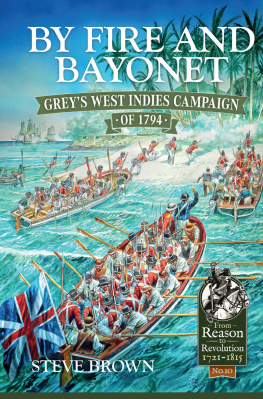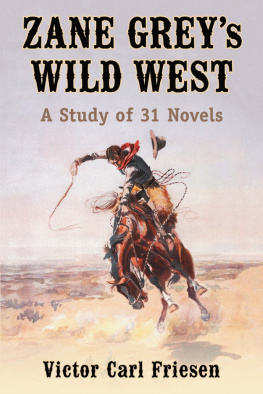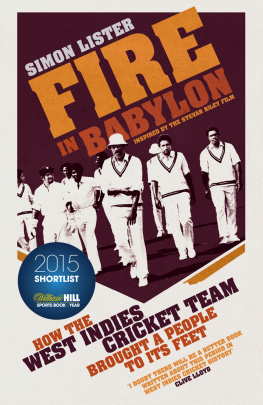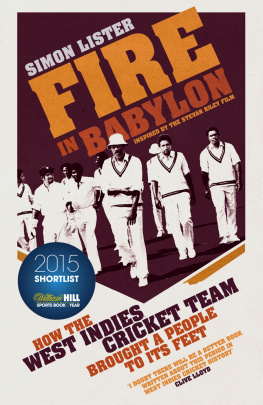There have been few books about Grey's glorious but ultimately ill-fated West Indies campaign in the early years of the long, terrible Great War of 1793-1815. Yet five of the subalterns in Grey's expeditionary force went on to command divisions in Wellington's Peninsula army, another two commanded the Iron Duke's Royal Artillery, and one Richard Fletcher famously, the Royal Engineers.
The tactics used by Sir Charles Grey were as far removed as can be imagined from the traditional image of the two-deep British line delivering massed volleys at point-blank range. The invasions of Martinique, Saint Lucia and Guadeloupe were raids, undertaken by troops instructed to operate in open order, in silence, and at bayonet-point. All attacks went in with unloaded muskets. Most of the heavy-duty fighting was undertaken by converged flank battalions, grenadiers and light infantrymen assembled under hand-picked field officers, and used as stormtroops in every major assault. Here were French Revolutionary War tactics that are largely unexplored and largely undocumented, at least in modern times.
Sir Charles Grey was one of the most aggressive British generals of the era, something his gentlemanly appearance and demeanour did not immediately indicate. Ever cheerful and optimistic, humane and loyal to his friends, his ability to deliver needle-sharp assaults and then harry a defeated enemy the latter being something at which British generals of the Napoleonic era were distinctly mediocre makes him one of the more interesting personalities of the early portion of the Great War with France. If he was not ultimately unsuccessful, it was not his fault. He was robbed of the resources he needed at the outset, then given virtually no reinforcements by Horse Guards.
The great killer on this campaign was not the French. It was disease principally Yellow Fever. Of the 6,200 men who landed with Grey on Martinique in February 1794, some 4,100 were dead by Christmas.
Such then is By Fire and Bayonet , an account of a very dramatic period for the British Army in the West Indies. It took many years to learn the lessons presented by the campaign, but for the young officers who survived, it provided some invaluable lessons that put to good use fifteen or twenty years later, in the British Army of a later era.
Steve Brown is the author of Wellingtons Redjackets , the history of the 45th Regiment of Foot 1807-1815, and has edited and annotated Helions re-issue of William Browns The Autobiography, or Narrative of a Soldier . He also a frequent contributor to, and book reviewer for, The Napoleon Series website.
By Fire and Bayonet
Grey's West Indies Campaign of 1794
Steve Brown
Helion & Company Limited
26 Willow Road
Solihull
West Midlands
B91 1UE
England
Tel. 0121 705 3393
Fax 0121 711 4075
Email:
Website: www.helion.co.uk
Twitter:
Visit our blog at
Published by Helion & Company 2018
Designed and typeset by Mach 3 Solutions Ltd (www.mach3solutions.co.uk)
Cover designed by Paul Hewitt, Battlefield Design (www.battlefield-design.co.uk)
Text Steve Brown 2017
Maps Steve Brown 2017
Cover: The Landing at Martinique (Painting by Peter Dennis Helion & Company 2017)
Every reasonable effort has been made to trace copyright holders and to obtain their permission for the use of copyright material. The author and publisher apologise for any errors or omissions in this work, and would be grateful if notified of any corrections that should be incorporated in future reprints or editions of this book.
ISBN: 978-1-911512-60-8
eISBN: 978-1-91286-694-6
Mobi ISBN: 978-1-91286-694-6
British Library Cataloguing-in-Publication Data.
A catalogue record for this book is available from the British Library.
All rights reserved. No part of this publication may be reproduced, stored in a retrieval system, or transmitted, in any form, or by any means, electronic, mechanical, photocopying, recording or otherwise, without the express written consent of Helion & Company Limited.
For details of other military history titles published by Helion & Company Limited, contact the above address, or visit our website: http://www.helion.co.uk
We always welcome receiving book proposals from prospective authors.
Contents
.
.
.
.
.
.
.
.
List of Plates
A typical British infantryman of the era in West Indies tropical service uniform. (Anne S K Brown Collection)
Lieutenant General Sir Charles Grey. Defeated as much by his own superiors and failing health as by the French, he deserves to be remembered as one of Britains best generals of the era. (National Portrait Gallery)
Vice Admiral Sir John Jervis. A fist of iron in a velvet glove. The naval commander and Greys best friend. (National Portrait Gallery)
Fort Royal, called Rpublique-ville in 1794. (Anne SK Brown Collection)
His family motto was To live and die valiantly; Donatien-Marie-Joseph de Vimeur, vicomte de Rochambeau certainly lived up to his creed commanding the French defence of Martinique in February and March 1794. (Public Domain)
Saint Pierre in 1794 as depicted satirically by Cooper Wylliams. Note the guillotine, and heads on spikes. (Anne S K Brown Collection)
A view across the bay towards Fort Louis on the right (called Fort de la Convention in 1794) with Greys light infantrymen in the foreground. (Anne SK Brown Collection)
The Royal Navy in action against Forts Bourbon and Louis (Rpublique and Convention). (Anne SK Brown Collection)
The valiant Captain Robert Faulknor leads HMS Zebra to glory at Fort de la Rpublique. His death the following year robbed the Royal Navy of a fine officer. (Anne SK Brown Collection)
The storming of Fort Royal on 24 March 1794. The uniform details are probably incorrect. (Anne SK Brown Collection)
The town of Basse-Terre in Guadeloupe in 1794. (Anne SK Brown Collection)
The beginning of the end. The capitulation of the defenders of Fort Fleur dEpe on 7 June 1794. Much worse was to follow at Berville and Fort Matilda. (Public Domain)
Lieutenant General Robert Prescott. Undeniably valiant, but one of the most difficult subordinates to ever serve a field commander. (National Portrait Gallery)
List of Maps
| The West Indies Theatre |
| Greys movements on Martinique, March 1794. |
| The Capture of Saint Lucia, April 1794. |
| The Capture of Guadeloupe, April 1794. |
| The Loss of Guadeloupe, October-December 1794. |
Preface
Sir Charles Greys glorious but sadly ill-fated West Indies campaign in the early years of the long, terrible Great War of 1793-1815 is all but forgotten today. The time is right to bring it into the light, and reveal in equal parts the valour and squalor of close fighting in those far-off days. Practically none of the men who fell found remembrance beyond the end of that endless war, let alone white tombstones in grassy parks. Most died from fever, a fate far worse than a musket-ball, and most did die: some two-thirds of Greys force, a death-rate worse than that ascribed to the so-called butcher generals of 1914-1918.













